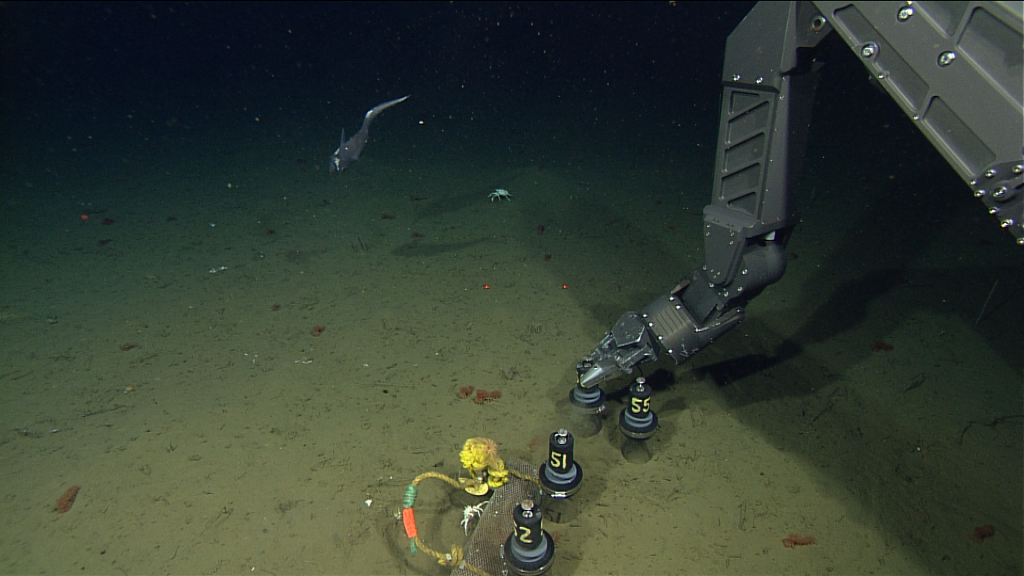 The Secret Oceanic Life of a Tree
The Secret Oceanic Life of a Tree
Each day a tree dies. Its carcass may lay there on the forest floor, ravaged by fungus, insects, and plants as they grow from its remains. But, perhaps the tree meets a watery grave–gently floating down river ultimately finding itself bobbing in the ebb and flow of the tides. Eventually this tree becomes waterlogged and begins sinking.
At a critical depth and pressure the ocean squeezes the last bit of terrestrial air out of the wood replacing it with brine. So begins the story with a tree sinking into the deep. Wood falls range from small fragments to 2000+ pound behemoths. In the deep, devoid of light and plants, a wood carcass brings a rare commodity—food. The amount of carbon a tree or piece of wood brings to the seafloor can be anywhere from ten to a thousand times that regularly encountered on the seafloor. From the carcass comes nourishment to sustain deep-sea life.
Ocean Creatures Eat Snacks From Land
What’s surprising given the rarity and uncertainty of that wooden treat along the deep-sea floor, is that wood falls possess a fauna wholly specialized for living and consuming them. The digestion of a fibrous and solid food source requires talent, a hearty gut, and some bacterial help–traits not many species possess. These organisms finish the tree off, tearing it apart from inside and out. Bivalves of the genus Xylophaga (measuring less than an inch) use a ridged shell to bore into the wood, ingesting the wood fragments. On their gills they host an endosymbiotic bacteria that can digest their woody snack. But, something extraordinary also happens on wood falls, special bacteria anaerobically breakdown the wood. One of the by-products of this, sulfide, can be used by chemosynthetic bacteria, similar those at hydrothermal vents. These bacteria provide a tasty snack for animals at wood fall. Scientists know little of which species gain nutrition through a pure wood versus the sulfur route. Nor do we know which species are preying upon others. And the evolutionary pathways that created these eccentric creatures are unknown! Of course, we also do not have idea how larvae in the oceans even locate these wood falls in the expanses of the deep ocean–the preverbal needle in a haystack.
 Chunking Wood Into the Ocean: The Experiment!
Chunking Wood Into the Ocean: The Experiment!
In 2006, Jim Barry (Monterey Bay Aquarium Research, MBARI) and I (with the generous support of MBARI) chunked 36 logs overboard to begin to examine wood fall communities. Chunked may be a strong verb for sending them down on a benthic elevator. Once on the bottom, a remotely operated vehicle dispersed them over a 1600 square foot area now affectionately referred to as Deadwood. In 2011 and 2013, we retrieved these wood falls. On the surface, I and others picked through the once solid but now bore-riddled and crumbling logs for Xylophaga, limpets, worms, snails, and other wee beasties. As we picked through the rotting wood carcasses, my level of excitement was only matched by the sulfidic, rotten egg, stench of decomposition. Now we seek to quantify wood-fall biodiversity, construct the food web using stable isotopes, and use genetics to understand where these species came from both in terms of larval transport in the oceans and their evolutionary past.
Why Wood Falls Are the Perfect Test System: The Scientific Perspective
Energy availability has long been recognized as a predictor in ecology and evolution, but the actual relationships between energy availability and biodiversity and adaptation remain unclear. One challenge is that determinants of available energy in natural systems are diverse and often unidentifiable. Multiple, functionally distinct sources of energy exist in terrestrial, freshwater, and coastal marine systems, and energy from these sources flows across landscapes and habitat boundaries. Wood-fall communities in the deep sea are an ideal test system for many theories about ecology, evolution, and energetic theory for three reasons. First, the amount of energy available to the wood fall organisms can be precisely manipulated in the form of wood mass. Second, flows of energy from wood through the community can be easily tracked because animals supported by wood are isotopically distinct from other animals in the background benthos. Finally, the entire community associated with a wood fall can be sampled, allowing for accurate estimates the complete biodiversity.
Press On My Wood Fall Work
The Marine Creatures That Only Live on Land Plants by Ed Yong at National Geographic
The Second World That Forms On Sunken Trees by Ed Yong at National Geographic
Why Is This Marine Biologist Throwing Logs Into The Ocean? by Roxanne Palmer at International Business Times
Wood: Is It What’s For Dinner? by Miss Cellania at Neatorama
The surprising life of a piece of sunken wood by Sarah Zielinksi at Science News
Fallen trees form a sea-floor feast at Nature
Shipwrecks and dead trees become home for deep-sea life by Laura Poppick at Live Science (image gallery)
My Writings on the Wood Fall Work
McClain, C.R. and J.Barry (2014) Beta-Diversity on Deep-Sea Wood Falls Reflects Gradients in Energy Availability. Biology Letters (online early)
Will My Wood Research Be Poplar by Craig McClain at Deep-Sea News
A Lonely Tree Far From Home Brings New Life to the Ocean Deep: A Narrative in Five Acts by Craig McClain at Deep-Sea News
Wood, It’s What’s For Dinner by Craig McClain at Deep-Sea News
I Got Wood by Craig McClain at Deep-Sea News